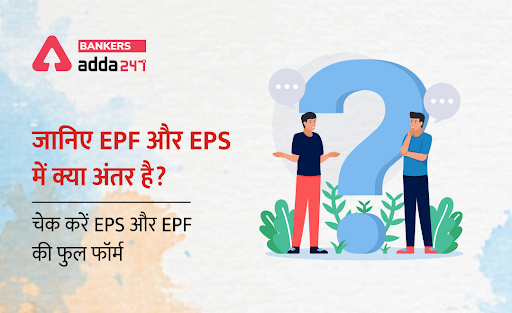EPS ka full form, EPS के लिए कौन पात्र है?
कर्मचारी भविष्य निधि (Employee’s Provident Fund) 1952 के अधिनियम के तहत दो योजनाएं बनाई गई थी पहली कर्मचारी भविष्य निधि (EPF) और दूसरी कर्मचारी पेंशन योजना (EPS). ईपीएफ (EPF) और (EPS) ईपीएस को केंद्र सरकार द्वारा लागू किया जाता है जिसमें केंद्र और राज्य सरकार के प्रतिनिधि, नियोक्ता और कर्मचारी दोनों शामिल होते हैं। आज इस आर्टिकल में EPF और EPS में क्या अंतर है? और इससे जुड़ी अन्य महत्वपूर्ण डिटेल पर चर्चा करेंगे.
कर्मचारी भविष्य निधि क्या है (what is an Employee Provident Fund (EPF)?
कर्मचारी भविष्य निधि एक ऐसी योजना है जो किसी व्यक्ति की सेवानिवृत्ति के लिए की गई बचत को बनाए रखने में मदद करती है। यह एक रिटायरमेंट योजना है जो कॉर्पोरेट क्षेत्र के सभी कर्मचारियों के लिए उपलब्ध है। इस योजना में एक तरफ कम्पनी का मालिक दूसरी और कर्मचारी दोनों का बराबर योगदान होता हैं जो व्यक्ति की जब तक कर्मचारी उस कंपनी में कार्यरत होगा तब तक की राशि कर्मचारियों के खाते में जमा होती है।
कर्मचारी पेंशन योजना क्या है? (What is the Employee Pension Scheme (EPS)?
कर्मचारी पेंशन योजना एक ऐसी योजना है जो कर्मचारियों को प्राप्त पेंशन का भुगतान करती है। यह योजना विशेष रूप से उन कर्मचारियों के लिए उपलब्ध है जो ईपीएफओ(EPFO) के सदस्य हैं और उन लोगों के लिए भी जिन्होंने ईपीएस (EPS) खाते में अपना योगदान दिया है। ईपीएस (EPS) में योगदान कम्पनी की ओर से होता है। ईपीएस में कम्पनी कर्मचारियो के वेतन का 8.33% जमा करती है। कर्मचारी पेंशन योजना में 58 वर्ष की आयु के बाद पेंशन मिलती है
EPF और EPS में क्या अंतर है (Difference Between EPF and EPS)
EPF और EPS दोनों अलग-अलग योजनाएं है और दोनों के लाभ भी अलग-अलग हैं। EPF और EPS के बीच का अंतर समझने के लिए नीचे दी गई तालिका को अच्छी तरह से पढ़ना होगा:
|
Element |
EPF |
EPS |
|
Employee’s |
12% of basic |
Nil |
|
Employer’s |
3.67% of |
8.33% of the |
|
Eligible |
All |
Employees |
|
Interest on |
EPF is The interest rates |
No interest |
|
Maximum |
The |
The |
|
Tax |
Interest But if the If the No tax on |
Pension and |
|
Withdrawal of |
After 58 |
Pension is |
FAQs: Difference Between EPF and EPS
Q. EPS की फुल फॉर्म क्या है?
Ans: EPS की फुल फॉर्म है कर्मचारी पेंशन योजना।
Q. EPF की फुल फॉर्म क्या है?
Ans: EPF की फुल फॉर्म है कर्मचारी भविष्य निधि।
Q. EPF में कर्मचारी का योगदान कितना होता है?
Ans: मूल वेतन और महंगाई भत्ते का 12 प्रतिशत











